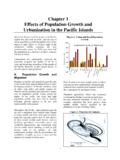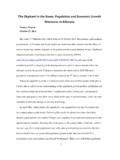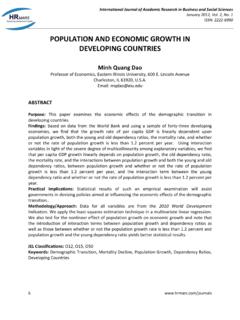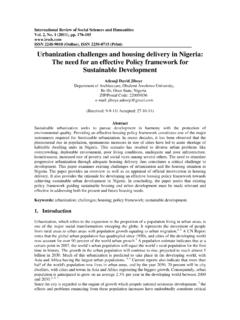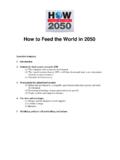Transcription of KEY DRIVERS OF CHANGE - Food and Agriculture …
1 KEY DRIVERS OF CHANGE813 KEY DRIVERS OF CHANGEC ross-sectoral impacts continue to dominate CHANGE in forestryAcross most of the GMS, CHANGE in forestry is largely driven by what happens outside the sector. Increasing populations, rising purchasing power and increasing levels of international trade are placing greater demands on forests. Road network development is widening accessibility and international investment in Agriculture is driving new trends in rural economic activity. Extraction of forest products and establishment of Agriculture and planted forests, are altering the extent and species composition of forests and reshaping the rural landscape.
2 In general, low wages, rich soils, favourable climate and higher prices for agricultural goods motivate deforestation (Chomitz 2007). Unclear land tenure and weak governance also exacerbate deforestation, although even where tenure is secure and governance is strong forest clearance may be the preferred option. Changes in the composition of economies away from rural sectors and development of urban middle classes may, however, drive demand for environmental services and away from extractive uses of forests. Policy is often driven by hidden hands Mediating current changes, institutional developments are playing an increasing role and sea changes in policy have taken place as a result of infl uences that are often paid scant attention in forestry.
3 Environmental shocks and calls for social and economic justice, land allocation processes and the effects of overseas remittances and off-farm employment are examples of the hidden hands driving CHANGE in forestry in the GMS. These infl uences have in some cases proven stronger than more direct efforts to promote sustainable management of forests and may provide greater stimulus for forest transitions in the developments also affect forestryCultural alterations are also helping to pave the way for changes in forestry and rural development. APFSOS I in 1998 noted the increasing integration between communities, mass organizations, environmental NGOs, governments and the private sector.
4 In recent years, global increases in environmental awareness have signalled further modifi cation in the stimulus for forest governance reform in the subregion. There is a wide range of developments likely to affect the direction of progress with SFM. Those identifi ed by ITTO are summarized in Box c Forestry Sector Outlook Study II The Greater Mekong Subregional reportBox Developments that may affect progress with SFM ITTO listed the following DRIVERS as k ey infl uences on progress towards SFM in tropical countries: The expansion of planted forests and the use of agricultural tree crops for timber may reduce pressure on the natural forest by supplying an increasing proportion of wood production.
5 Declining timber prices and/or increased prices for agricultural products would undermine efforts towards SFM. Greater focus on the management of high-value timber species, an expanded range of species and/or increased value addition could increase the profi tability of natural forest management. Climate CHANGE could affect forest growth , yield and even survival. A general drying in the tropics could lead to an increased incidence of forest fi re and drought-related changes to forest structure. Conversely, increased rainfall could lead to higher rates of forest growth and could also cause more erosion, landslides and fl ooding.
6 Greater security of tenure may help to increase sustainable management. The situation of those peoples who live in or near the forest is unlikely to remain static. If living standards improve and migration to urban centres continues, local pressures on forest may decrease. Decentralization may align forest management more closely with local interests, but there is no guarantee that this will favour SFM. As affl uence increases, public pressure could induce governments to improve management and pay more attention to environmental values.
7 The global community could increase its payments for the global environmental services provided by natural tropical forests, thereby improving the economic viability of : ITTO (2006). DEMOGRAPHIC CHANGESBy 2020, an additional 21 million people will join the subregion s populationThe total population of the GMS in 2010 stood at 227 million. By 2020 an additional 21 million people will join the subregion s population , representing a net growth of 9 percent (UN population Division 2006). Viet Nam and Thailand account for 69 percent of the subregion s inhabitants but only 36 percent of GMS forest area (Figure ; Table ).
8 Viet Nam is the most densely populated country in the region although, as elsewhere in the subregion, population growth rates have been slowing (Table ). KEY DRIVERS OF CHANGE83 Figure population distribution among GMS countries, 2010 Source: UN population Division (2006).Rural to urban migration is acceleratingWith increasing levels of socio-economic development, subsistence-based economic systems are giving way to increased industrialization and service delivery while rates of rural to urban migration are accelerating. Proportions of populations living in rural areas are relatively even across the GMS, although Cambodia and Lao PDR remain less urbanised (Table ).
9 In Cambodia, Lao PDR and Viet Nam, the rural population is still expected to rise, but at a pace below the rate of overall population growth . Myanmar and Thailand have lower rates of population growth and population densities in rural areas are expected to remain relatively static up to 2020. Table Total population , population density and rural population percentage in the GMS, 1990-2020 population 2005 (000) population density/km2 Total populationRural population Annual CHANGE (%) (%)Annual CHANGE (%)1990-20052005-20201990-20052005-2020 Cambodia13 PDR5 Nam85 c3 604 : UN population Division (2006).
10 84 Asia-Pacifi c Forestry Sector Outlook Study II The Greater Mekong Subregional reportRural depopulation will affect forestry in various waysData in Table demonstrate that, notwithstanding the recent economic downturn, rural livelihoods are becoming less attractive. The long-term effects of rural depopulation on forestry are dependent on a number of factors. Although regrowth and expansion of forests may occur as people leave the land, low rural incomes and inappropriate land-tenure systems and policy environments may motivate depletion of remaining resources.










